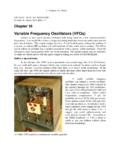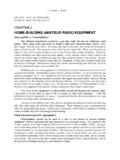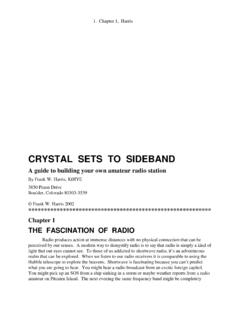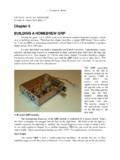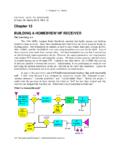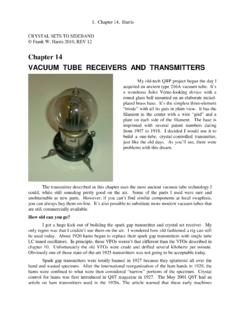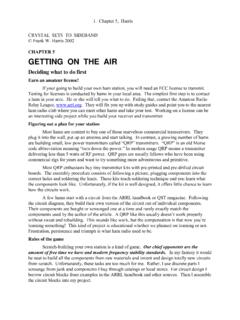Transcription of Chapter 12 SIMPLIFIED QRO AMPLIFIER DESIGNS
1 1. Chapter 12, Harris CRYSTAL SETS TO SIDEBAND Frank W. Harris 2010, REV 12 Chapter 12 SIMPLIFIED QRO AMPLIFIER DESIGNS When I first got back on the air as a retiree, I built a QRP that put out 4 watts on 15 meters. I spent two days answering CQs and calling CQ. Unfortunately no one heard me. I came to the (incorrect) conclusion that QRP is a hobby for guys with expensive, huge beam antennas, not guys with verticals and dipoles. Without that extra 10 dB of gain, I figured my QRP signal must be down in the noise. The other way to get 10 dB of gain is an AMPLIFIER .
2 Transmitting more than 5 watts is called QRO. In this Chapter I shall describe my efforts to build a good linear AMPLIFIER . Having QRO power when I need it has made my transmitter a reliable communications system. With 50 or more watts, your contacts won't have to work so hard to hear you and rag-chewing becomes practical. Now that I m older and wiser, I realize that low power and simple antennas weren t my biggest problem. In the old days our receivers had passbands several KHz wide and most beginners were stuck with a couple crystals for each band. After we called CQ, we tuned up and down the entire band looking for replies.
3 In contrast, today guys with modern receivers are usually just listening to a few hundred Hz. When I put my 4 watts on 15 meters, I didn t realize that using the upper sideband is the standard convention for 20 meters and higher. On 15 meters the other stations were tuned to the upper sideband while I was often zeroed in on the lower sideband. My old (1967) homebrew receiver was so wideband, it wasn t obvious to me which sideband I was on. When I answered those CQs, I was usually off their frequencies by about KHz. In this Chapter I describe three different final AMPLIFIER DESIGNS that I used successfully on the air.
4 I don t recommend building the first one. I describe it here because it was educational. It was a tuned class B AMPLIFIER . It worked, I learned from it, and it covers 20 through 10 meters. Unfortunately, it was too hard to tune. Moreover, you would probably have a hard time finding a dual-section, butterfly variable capacitor like the one I used to tune the output to resonance. The second AMPLIFIER is an untuned class B design . It works on all bands and is suitable for CW only. Someday when you graduate to single sideband phone you can upgrade this AMPLIFIER to the third design , which is an all band Class AB linear AMPLIFIER .
5 Rather than just read the descriptions of the finished products, you may gain some insights by reading my odyssey of how I worked my way up to a real linear AMPLIFIER . The quest to build a 50 watt AMPLIFIER I began my QRO project by searching my 1998 ARRL handbook for linear AMPLIFIER construction projects. I found three examples of linear amplifiers. One of them, An HF 50 Watt Linear AMPLIFIER , was a complex schematic that covered two pages. The other two examples were buried in diagrams of elaborate transceivers that seemed to be illustrative rather 2. Chapter 12, Harris than something I was encouraged to build.
6 I could almost hear a deep baritone voice saying, For your own safety, do not build this at home. I studied the HF 50 watt linear AMPLIFIER project closely. It used a pair of MRF-477 transistors. I looked them up in my RF Parts Company catalog. It said, call for pricing. That was ominous. It turned out that a pair of them was $45. I also worried about all those feedback loops and clamps that protected the transistors from overdrive, from excess SWR, from excess collector voltage, and from thermal runaway. In addition, there were at least three kinds of frequency compensation feedback.
7 In short, the schematic seemed to be telling me that high power RF transistors are extremely fragile. The article gave me the impression that, if all those protection circuits didn t work perfectly the first time I turned it on, my pricey transistors would turn into toast before I could say, expletive deleted. I had never built a high power transistorized RF power AMPLIFIER before. My only comparable previous projects had been 200 and 300 watt switching power supplies. Until I got those projects working, they had devoured numerous $20 transistors like popcorn.
8 I was extremely wary of this project. I retreated to my 1979 handbook and found a more primitive linear transistor AMPLIFIER project. This one also had thermal protection, but at least they implied that it didn t have to work perfectly in concert with a flawlessly adjusted bi-directional power meter. The most reassuring feature was that MRF-454 transistors seemed to be the cheapest power transistors available, about $13 each. These transistors are big, rugged, and able to dissipate a great deal of heat. Just in case, I bought two extra sets of transistors. At this point you may be thinking that, even at $13, those are expensive transistors!
9 Why doesn t he use a cheaper power transistor that has adequate power and frequency ratings? The answer is that the MRF-454 will produce high power with a 12 volt power supply. Sure, if you re willing to build a 48 volt, 200 watt DC power supply, you can find dozens of really cheap transistors that will work well. 3. Chapter 12, Harris Basic features of a modern linear AMPLIFIER A typical modern amateur radio linear final AMPLIFIER has six basic features: First, Two separate power transistors are driven with a center-tapped transformer. The driver transformer is wired so that it turns on one transistor for half of the sine wave while the other transistor is turned off.
10 During the next half cycle, the first transistor turns off while the second transistor turns on. Second, it is a class B design operating in push pull. An advantage of class B is that, when there is no RF on the input, both transistors are nearly completely turned off. This means that they don t get hot and don t waste energy. Even when running with forward bias to make the AMPLIFIER linear, very little forward bias is needed and the efficiency approaches 50%. Also, class B tends to cancel out even harmonics. Third, the transistors must be cooled with a large heat sink. Large power transistors are designed to be bolted onto a heat sink.
